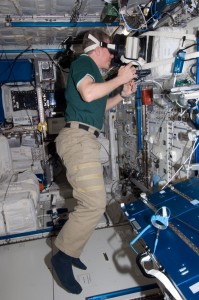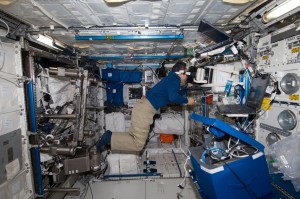Great news today from ESA’s Mission Science Office (MSO) – a milestone passed this week with the completion of the very last inflight session of PASSAGES, one of the European science experiments on the International Space Station. The following update was received from the MSO:
When you approach a door or any other opening, do you have any idea how your brain actually manages to decide whether you can pass through it? Obviously you do not carry around a ruler to measure how wide the opening is and then calculate and compare with your shoulder width. Your brain is apparently smarter than that! But how?
The PASSAGES experiment being done on-board the ISS is all about the strategies our brain uses in the perception of the world around us. In this experiment, we want to know if the strategies involved on Earth continue to be used when the astronaut is in a weightless environment for a long period.
In particular, we would like to know whether the fact that astronauts spend most of their time floating has an effect on their ability to judge distances and sizes, based on visual information alone. Does the lack of weight, and the lack of contact with the world generate visual illusions or errors in perception? Previous experiments on the ground and in parabolic flight suggest that it might.
To investigate this question, the participating crew members see 3D scenes on a laptop screen, just like a video game. The scene is a room with an opening which can vary in width. Their task is to decide if he or she could pass through the aperture without rotating or scrunching the shoulders.
The science team uses typical methods from psychophysics and manipulates several factors to investigate the strategies used by the participant. The science team will compare the performances obtained on ground with those obtained on-board the ISS. From that, the team will be able to conclude whether Earth-adapted strategies lead to modifications or maybe even errors in the perception of visual space during spaceflight.
André’s colleague Dan Burbank has performed his final PASSAGES session this week. With nine other crew members having previously participated in the experiment, Dan has concluded all in-flight activities for the PASSAGES experiment.
Of course Dan will still be doing some measurement sessions on-ground after his return to Earth. Nevertheless the champagne was set cold in the CADMOS User Support & Operations Centre where the science team was following this very last in-flight session for this experiment.
Congratulations to all involved on the completion of PASSAGES inflight activities! Looking forward to the scientific results and publications!



Discussion: no comments